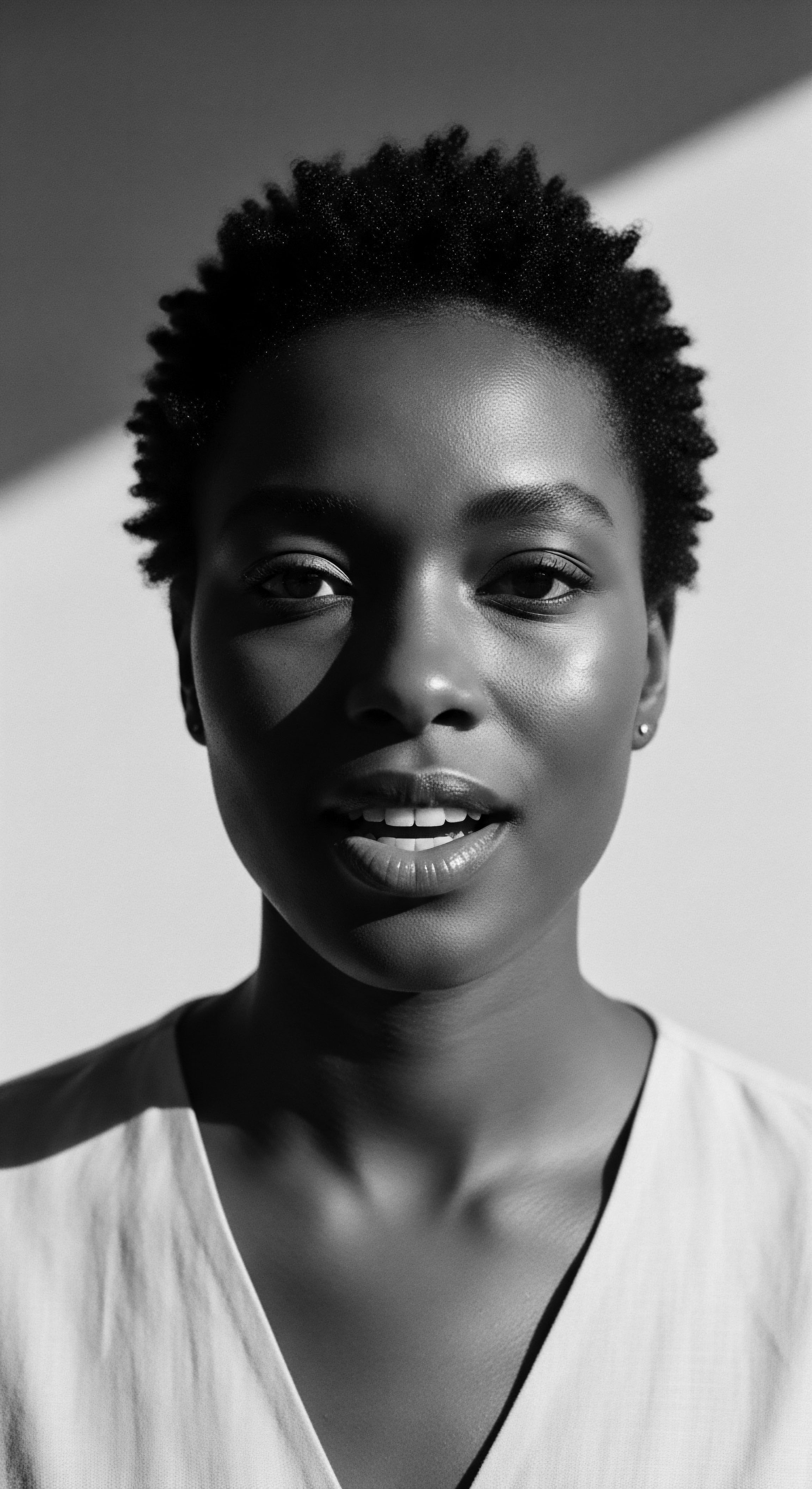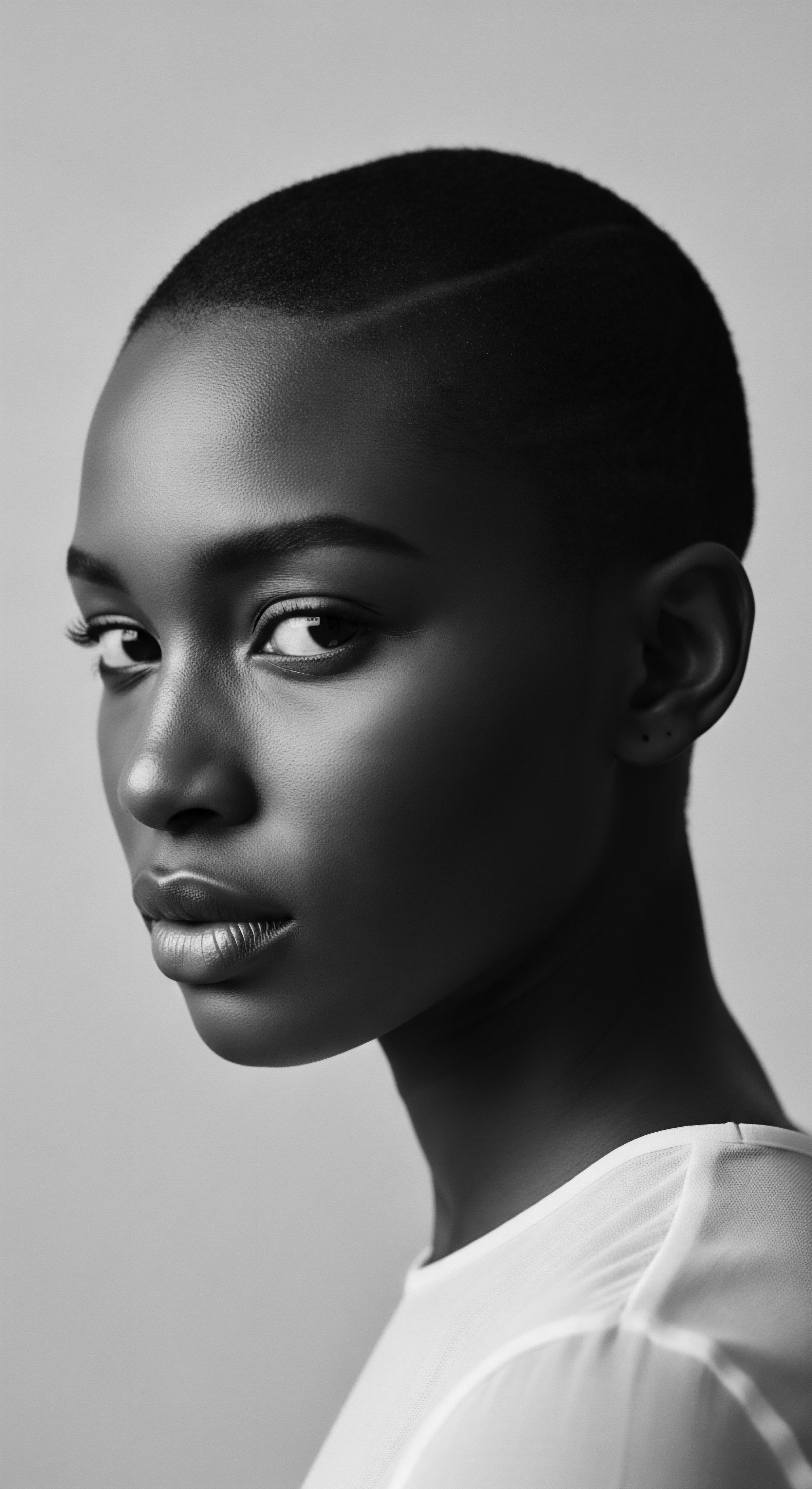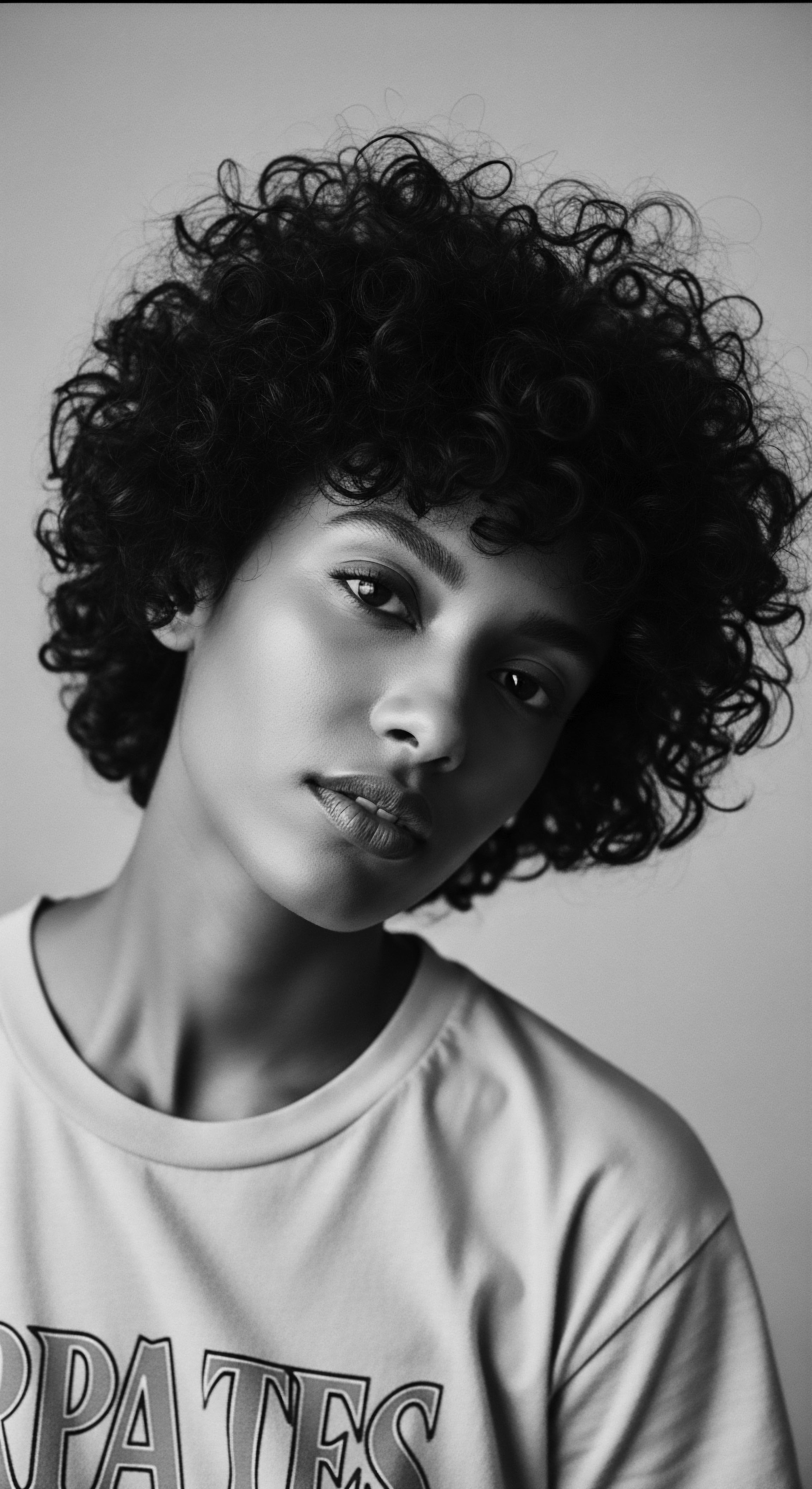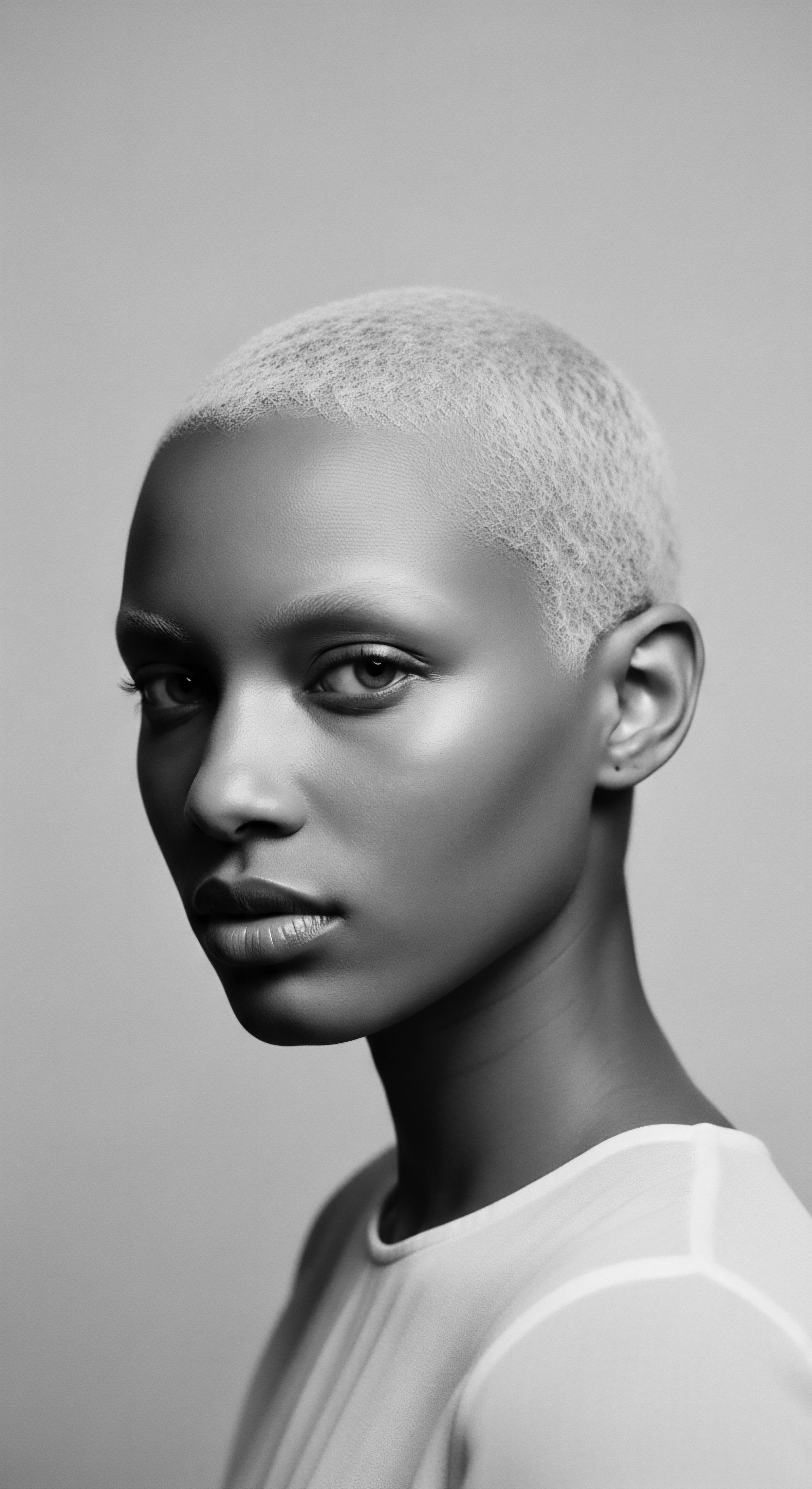
Fundamentals
At the very core of a hair strand, anchoring its resilience and defining its unique form, lie the Disulfide Bonds. These powerful chemical connections, formed between sulfur atoms within the keratin protein chains, are not merely structural components; they are the invisible architects of hair’s inherent memory, particularly evident in the glorious spirals, coils, and waves of textured hair. Their very existence speaks to an ancient design, a molecular blueprint that has shaped the diverse crowns worn across generations and continents. Disulfide bonds represent the strongest of the three types of bonds found in hair, alongside hydrogen and salt bonds, providing the hair shaft with its remarkable strength and stability.
The meaning of disulfide bonds, at its most fundamental, refers to these robust covalent linkages. They are the primary determinant of a hair strand’s permanent shape, influencing whether hair presents as straight, wavy, curly, or tightly coiled. Unlike hydrogen and salt bonds, which can be temporarily altered by water or heat, disulfide bonds require chemical intervention to break and reform. This characteristic explains why permanent changes to hair texture, such as those achieved through perms or relaxers, necessitate strong chemical solutions.
For textured hair, the arrangement and density of these bonds are particularly significant. The unique curvature of a coil or curl is a direct manifestation of how disulfide bonds are distributed along the hair fiber. This structural integrity has been observed and honored in ancestral hair practices for millennia, long before the advent of modern chemistry. Indigenous communities, across various continents, intuitively understood the hair’s enduring nature, developing methods of care and adornment that worked in harmony with its inherent structure.
Disulfide bonds are the foundational anchors of hair’s inherent shape and resilience, particularly crucial for the diverse forms of textured hair.

The Hair’s Ancient Blueprint
Consider the earliest expressions of hair care, which arose from deep observation of nature and the human body. Ancient African civilizations, for instance, celebrated and adorned their hair as a symbol of cultural identity and spirituality. Hairstyles were often intricate, carrying deep cultural meanings.
While they did not possess the scientific vocabulary of ‘disulfide bonds,’ their meticulous braiding, twisting, and adornment practices, often involving natural butters and botanical blends, implicitly respected the hair’s structural integrity. These practices aimed to preserve the hair’s health and maintain its shape, safeguarding it against environmental elements.
- Keratin’s Core ❉ Hair primarily consists of a protein called keratin, a fibrous structural protein. Within keratin, amino acids link together to form polypeptide chains.
- Cysteine’s Role ❉ A specific amino acid, Cysteine, contains sulfur atoms. When two cysteine molecules are in close proximity, their sulfur atoms can bond, forming a disulfide linkage, creating a new molecule called Cystine.
- Structural Stability ❉ These disulfide bonds connect different polypeptide chains within the keratin structure, or even different parts of the same chain, providing immense stability and contributing significantly to the hair’s mechanical properties, such as its tensile strength.
The inherent meaning of these bonds, therefore, extends beyond mere chemical architecture; it encompasses the very capacity for hair to retain its form, to resist external forces, and to serve as a canvas for cultural expression. The foundational stability provided by disulfide bonds allowed for the development of complex, long-lasting hairstyles that communicated identity, status, and community roles across African societies.

Intermediate
Moving beyond the foundational understanding, the intermediate meaning of disulfide bonds reveals their dynamic interplay with external forces and internal resilience, especially within the context of textured hair’s journey through history. Disulfide bonds are the primary reason textured hair maintains its spirals and coils, as their distribution and quantity dictate the hair’s natural curvature. This structural specificity means that altering the natural pattern of textured hair requires a direct chemical interaction with these bonds.

The Chemistry of Transformation
The manipulation of disulfide bonds is the underlying principle behind permanent hair alteration techniques, whether for straightening or curling. A process known as reduction breaks these bonds, allowing the keratin chains to shift into a new configuration. Subsequently, an oxidation process reforms the bonds in their new positions, locking in the desired shape. This chemical dance has profoundly impacted the care and styling practices within Black and mixed-race communities for centuries.
Consider the historical evolution of hair straightening. The hot comb, a metal tool heated over fire or a stove, gained popularity in the late 1800s, offering a temporary way to smooth hair. While not directly breaking disulfide bonds, the intense heat temporarily reconfigured hydrogen bonds, creating a straighter appearance. This method, though less damaging than later chemical processes, still represented an early effort to alter hair’s natural state to align with prevailing beauty standards.
The true chemical intervention arrived with the advent of hair relaxers. Garrett Augustus Morgan Sr. an African American inventor, is credited with creating the first chemical relaxer in 1909.
His accidental discovery, while working on a sewing machine lubricant, led to a formula that successfully loosened curly textured hair. This marked a significant, albeit complex, turning point in Black hair care.
The chemical manipulation of disulfide bonds, historically through relaxers, represents a complex interplay between scientific innovation and societal beauty standards.

Ancestral Echoes and Modern Applications
The concept of modifying hair’s structure is not entirely modern. Ancestral practices, while lacking a scientific understanding of disulfide bonds, often involved techniques that influenced hair texture and durability. For instance, the meticulous application of natural butters, clays, and oils in traditional African hair care, while primarily for moisture and protection, also contributed to the hair’s overall strength and manageability. Some communities used specific herbs or concoctions to impart certain qualities to the hair, possibly influencing its malleability or strength over time.
The understanding of disulfide bonds offers a scientific lens through which to appreciate the ingenuity of these historical practices. For example, some traditional styling methods involved tension and wrapping, which, when combined with natural emollients, could encourage temporary alterations to the hair’s curl pattern or enhance its elongated appearance. These methods, passed down through generations, speak to an intuitive knowledge of hair’s structural properties.
Today, the intermediate understanding of disulfide bonds informs the development of bond-building treatments, which aim to repair or strengthen these vital connections. These products, a direct response to the damage caused by chemical processing and heat styling, represent a modern return to prioritizing the integrity of the hair strand. They offer a pathway to restore hair’s natural resilience, echoing the ancestral reverence for healthy, robust hair.
| Historical Method Traditional Braiding/Twisting |
| Approximate Era Ancient to Present |
| Primary Effect on Hair Protective styling, elongation, pattern definition |
| Connection to Disulfide Bonds Maintained structural integrity, reduced mechanical stress on bonds |
| Historical Method Hot Comb Application |
| Approximate Era Late 1800s – Mid 20th Century |
| Primary Effect on Hair Temporary straightening, smoothing |
| Connection to Disulfide Bonds Primarily affected hydrogen bonds, intense heat could indirectly weaken disulfide bonds over time |
| Historical Method Chemical Relaxers (Lye-based) |
| Approximate Era Early 1900s – Present |
| Primary Effect on Hair Permanent straightening, curl reduction |
| Connection to Disulfide Bonds Directly broke and reformed disulfide bonds via strong alkaline agents |
| Historical Method Perms (Waving Lotions) |
| Approximate Era Early 20th Century – Present |
| Primary Effect on Hair Permanent curling, wave creation |
| Connection to Disulfide Bonds Directly broke and reformed disulfide bonds using reducing and oxidizing agents |
| Historical Method These methods illustrate humanity's long-standing desire to shape hair, with increasing scientific understanding revealing the underlying chemical mechanisms. |

Academic
The academic definition of Disulfide Bonds within the context of textured hair is a comprehensive elucidation of their molecular structure, their pivotal role in the biomechanics of hair, and their profound implications for the health, cultural identity, and historical experiences of Black and mixed-race communities. These covalent bonds, specifically formed between the sulfur atoms of two Cysteine residues, creating a Cystine unit, are the strongest chemical linkages within the keratin protein matrix of the hair fiber. They provide the hair shaft with its remarkable tensile strength, elasticity, and resistance to external forces. The precise arrangement and density of these bonds within the complex hierarchical structure of keratin — from alpha-helices to coiled-coil dimers, protofilaments, and intermediate filaments — directly determine the hair’s inherent curl pattern, its mechanical properties, and its capacity to recover from deformation.
From an academic perspective, understanding the chemical meaning of disulfide bonds necessitates an exploration of redox reactions. Hair perming and relaxing processes, for example, rely on a two-step chemical reaction ❉ a reducing agent (such as ammonium thioglycolate for perms or sodium hydroxide/guanidine hydroxide for relaxers) cleaves the disulfide bonds, converting cystine back into cysteine. This bond breakage allows the keratin chains to rearrange.
Subsequently, an oxidizing agent (like hydrogen peroxide) is applied to reform the disulfide bonds in their new, desired configuration, thereby permanently altering the hair’s shape. The efficacy and potential damage of these treatments are directly correlated with the extent and control of this bond cleavage and reformation.

The Weight of Alteration ❉ Disulfide Bonds and the Black Hair Experience
The historical application of chemical relaxers, specifically designed to permanently straighten tightly coiled hair, provides a poignant and academically significant case study regarding the manipulation of disulfide bonds and its profound societal ramifications for Black women. The desire for straightened hair in Black communities emerged from complex historical pressures rooted in Eurocentric beauty ideals that gained prominence during and after slavery. Enslaved Africans were often forcibly stripped of their traditional hairstyles upon arrival in the Americas, a dehumanizing act aimed at erasing their cultural identity. This historical trauma contributed to a pervasive societal preference for straight hair, often deemed “good hair,” which became intertwined with notions of professionalism, social acceptance, and beauty.
The introduction of chemical relaxers in the early 20th century offered a seemingly permanent solution to achieve this desired straight aesthetic. These products, particularly lye-based formulations containing sodium hydroxide, aggressively break a significant number of disulfide bonds, fundamentally altering the hair’s natural structure. While providing the intended straightening effect, the process often came at a severe cost to hair health, leading to breakage, thinning, and scalp irritation. The long-term consequences extend beyond cosmetic damage, revealing a disturbing public health concern.
A growing body of rigorous research highlights the potential adverse health outcomes associated with frequent and long-term use of chemical hair relaxers, disproportionately affecting Black women. Studies have linked these products, which can contain endocrine-disrupting chemicals like phthalates, parabens, and even formaldehyde, to increased risks of various hormone-related cancers and reproductive health issues.
The widespread historical use of chemical relaxers in Black communities, a direct manipulation of disulfide bonds, carries significant health implications rooted in societal pressures.
For instance, a study published in 2023 by researchers at Boston University’s Black Women’s Health Study (BWHS) reported that long-term use of chemical hair relaxers by postmenopausal Black women was associated with an increased risk of uterine cancer. Specifically, women who reported using relaxers more than twice a year or for more than five years experienced a greater than 50% increased risk of uterine cancer compared to those who never or rarely used them. This finding builds upon prior research linking relaxer use to other conditions such as uterine fibroids, preterm birth, and breast and ovarian cancers.
The data indicates that Black women, who historically account for a substantial majority of relaxer users (with up to 95% of adult Black women in the U.S. reporting ever use in older cohorts, and 84% in more contemporary studies), bear a disproportionate burden of these potential health risks.
This interconnected incidence between the chemical alteration of disulfide bonds via relaxers and adverse health outcomes underscores a critical public health and social justice issue. The pressure to conform to Eurocentric beauty standards, enforced through various societal mechanisms, led to widespread adoption of products that, unbeknownst to many users for decades, posed serious health threats. The meaning of disulfide bonds, in this light, expands to encompass not only their chemical function but also their historical role as targets in a beauty regimen often driven by external validation rather than hair health or ancestral reverence.
The ongoing natural hair movement, which gained significant momentum in the 2000s, represents a powerful reclamation of ancestral hair traditions and a rejection of these harmful beauty norms. It promotes the acceptance and celebration of natural hair textures, thereby reducing the reliance on chemical treatments that break disulfide bonds. This cultural shift reflects a deeper understanding of hair’s inherent structure and a commitment to holistic wellness that honors the body’s natural state. The movement encourages a return to practices that preserve the integrity of disulfide bonds, allowing hair to thrive in its authentic, divinely given form.
- Molecular Composition ❉ Alpha-keratin, the primary protein in hair, is rich in the amino acid Cysteine, which contains a sulfur atom.
- Bond Formation ❉ Two cysteine residues can form a covalent bond between their sulfur atoms, creating a Disulfide Bridge (S-S bond), forming Cystine. These bonds are significantly stronger than hydrogen or salt bonds.
- Structural Hierarchy ❉ Disulfide bonds stabilize the higher-order structures of keratin, from coiled-coil dimers to protofilaments and intermediate filaments, which aggregate to form the hair fiber’s cortex. The density and arrangement of these bonds are crucial for hair’s strength, elasticity, and curl memory.
- Chemical Manipulation ❉
- Reduction ❉ Hair relaxers and perms use reducing agents (e.g. thioglycolates, hydroxides) to break disulfide bonds, allowing the keratin chains to uncoil or stretch.
- Reshaping ❉ The hair is then physically reshaped (straightened or curled).
- Oxidation ❉ An oxidizing agent (e.g. hydrogen peroxide) is applied to reform the disulfide bonds in their new configuration, permanently setting the hair’s altered shape.
- Impact on Hair Health ❉ While chemical alteration offers styling versatility, it inherently compromises the hair’s structural integrity, leading to weakened strands, increased porosity, and susceptibility to breakage.
The academic pursuit of understanding disulfide bonds continues to refine our comprehension of hair’s resilience and vulnerability. Modern bond-repairing technologies represent a scientific effort to mend these crucial linkages, offering a pathway to mitigate damage and restore hair’s inherent strength. This scientific advancement, in many ways, aligns with the ancestral wisdom of preserving and nurturing hair, emphasizing its vitality as a reflection of overall well-being.

Reflection on the Heritage of Disulfide Bonds
The journey through the scientific and cultural landscape of disulfide bonds brings us to a poignant reflection on the enduring heritage of textured hair. These invisible architects of hair’s very form hold a profound significance, not just as molecular structures, but as silent witnesses to generations of resilience, adaptation, and profound self-expression within Black and mixed-race communities. The meaning of these bonds, once solely confined to the realm of biology, expands to encompass the rich tapestry of human experience, interwoven with ancestral wisdom and the continuous quest for self-acceptance.
For Roothea, the understanding of disulfide bonds is more than a scientific inquiry; it is a spiritual homecoming. It is a recognition that the tight coils, the voluminous waves, the intricate patterns of textured hair are not random occurrences, but a magnificent expression of nature’s design, shaped by the very bonds we have explored. The historical narratives surrounding hair alteration, driven by societal pressures, underscore the profound impact that external perceptions can have on one’s relationship with their inherent self. Yet, even through periods of imposed conformity, the soul of a strand, rooted in its disulfide bonds, held a memory of its authentic self, waiting for a time of liberation and celebration.
The resurgence of the natural hair movement stands as a powerful testament to this enduring spirit. It is a collective re-membering, a conscious decision to honor the ancestral blueprint of hair, to cherish its natural inclinations, and to heal the historical wounds inflicted by chemical alteration. This movement is a living library in itself, where knowledge of hair’s true nature, including the vital role of disulfide bonds, is passed down, not just through scientific texts, but through shared experiences, communal care rituals, and the joyful embrace of diverse textures.
The future of textured hair care, guided by a deeper appreciation for disulfide bonds, lies in a harmonious blend of scientific understanding and ancestral reverence. It invites us to move beyond superficial styling to a place of genuine care, where products and practices work in concert with the hair’s inherent design, rather than against it. This holistic approach, grounded in the wisdom of those who came before us, allows every strand to voice its unique identity, unbound and unburdened, truly reflecting the vibrant legacy of its heritage. The exploration of disulfide bonds ultimately reminds us that within each coil and curl lies a story of strength, beauty, and an unbreakable connection to our roots.

References
- Byrd, A. D. & Tharps, L. D. (2001). Hair Story ❉ Untangling the Roots of Black Hair in America. St. Martin’s Press.
- Collins, P. H. (2004). Black Sexual Politics ❉ African Americans, Gender, and the New Racism. Routledge.
- Davis, A. Y. (1981). Women, Race & Class. Random House.
- Harrison, S. & Sinclair, R. (2003). Hair colouring, permanent styling and hair structure. Journal of Cosmetic Dermatology, 2(4), 180-185.
- James-Todd, T. et al. (2023). Hair relaxer use and risk of uterine cancer in the Black Women’s Health Study. Environmental Research, 237, 116848.
- Johnson, A. (2018). The Science of Black Hair ❉ A Comprehensive Guide to Textured Hair Care. The Hair Scientist LLC.
- Patton, T. O. (2006). Hey Girl, Am I More Than My Hair? African American Women and Their Struggles with Beauty, Body Image, and Hair. Black Women, Gender, and Families, 1(2), 29-51.
- Robbins, C. R. (2012). Chemical and Physical Behavior of Human Hair (5th ed.). Springer.
- Soffritti, M. et al. (2002). Formaldehyde ❉ An experimental re-evaluation of its carcinogenicity by inhalation in Sprague-Dawley rats. Annals of the New York Academy of Sciences, 982(1), 87-108.
- Wise, J. M. (2000). Hair Story ❉ Untangling the Roots of Black Hair in America. St. Martin’s Press.
